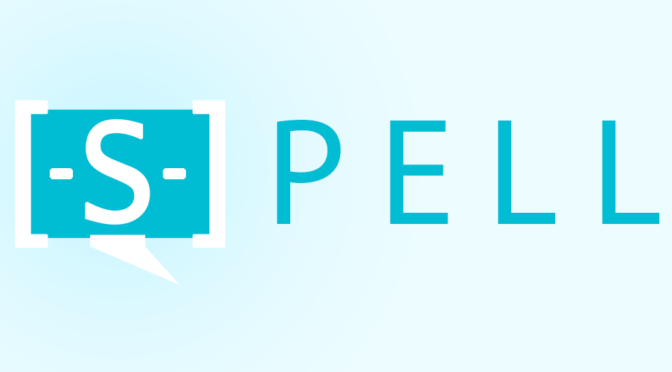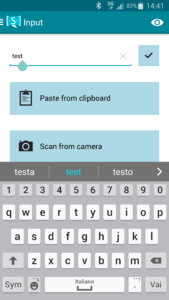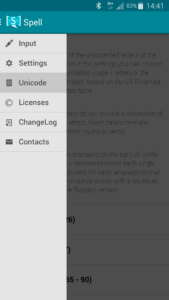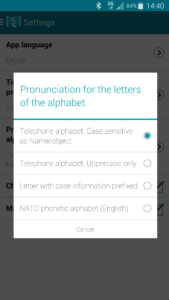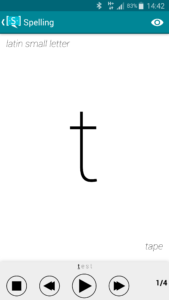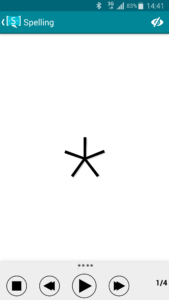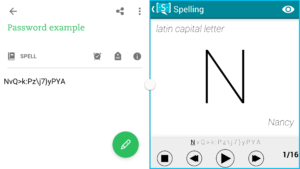The one-password apps make our lives easier by shouldering us from having to remember hundreds of complex passwords to keep safe our accounts, but when we have to type a very long and complex password into a computer that is not ours, from which we do not have access to our database, the situation can get frustrating, such as when we format our personal pc or if we can not leave them stored in the PC we’re currently using.
If our phone is so smart to remember all our passwords why it doesn’t “whisper” them to us when we need to type them out? The Text- to-Speech engines (TTS) are designed to emulate the normal conversation speech, when faced with texts composed of characters that do not resemble meaningful words we are likely to have unexpected results.
Raison d’être
Spell decomposes the input text into individual characters and provides a simplified view mode to browse them one by one as a magnifier, in addition each character is associated with a descriptive text intelligible by the TTS engine to allow the correct pronunciation, particularly the Latin letters from A to Z in upper case are associated with the values of the English Telephone Alphabet, based on the US Financial standard (Adam, Bob , etc.), facilitating activities such as :
- Writing passwords on pc on which we don’t have direct access to our DB passwords
- Writing serial numbers when we can’t paste a copied item
- Telephonic transmission of complex data
Other features:
- Support of the first 255 “printable” characters in the UTF-8 table commonly used by password generators, including the Latin alphabet, Greek alphabet, Cyrillic alphabet and their special characters
- one-tap paste to operate spelling on last copied text
- Support “sharing” text towards the App for instant spelling
- Optical Character Recognition (OCR) from camera or album
- Voice recognition to obtain the spelling
- mask characters during typing and spelling
- Translated in 6 languages: Italian , English, French , Spanish, German, Russian*
- Support for Samsung MultiWindow
*Each Language uses its own telephonic alphabet for uppercase latin letters, some translations are machine aided.
Pet-project PhoneGap
First of all this app is a pet project I’m using to study the PhoneGap framework, to explore its pros and cons starting from the most fragmented platform regarding both hardware and software, which is Android.
What most PhoneGap evangelists use as a mean to attract developers towards this platform is the “just HTML” argument, implying that because you’re developing for a browser with technologies that have been around for a lot of time that you can reuse is faster and simpler.
Reality tells a different story because you will not be developing just for a browser, but for all the different variations that come for every Android version, plus every device manufacturer, until KitKat version, had the bad habit to somehow customize the stockbrowser leading to an incredible jeopardized variety of bugs that no quality assurance team will be ever able to completely manage, also because some of them may depend on device’s hardware capabilities like GPU power and such.
So whatever you will develop, no matter how simple of an app may seem, deal with this in your mind: there will be bugs you can’t see nor foresee. To have a clue of what I’m talking about you can read the following list of issues I’ve collected and mostly resolved with a lot of sweat while developing Spell, most of which are rendering issues.
Android webview bugs, from 2.2 to 4.3 stock and 4.4 chromeview 30
Achieving a near-native UI and UX, at least on Android, is far from simple, yet possible. Depending on the project type and scope, given the right amount of thinking and planning, I think it’s truly possible to benefit from this approach as it does allow to create a reusable business logic to freely move between different mobile platforms.
Windows Mobile is moving his steps in this field with the WinJS library which allows a PhoneGap application on Windows Phone to render it’s HTML based interface like a native one by removing the browser abstraction layer, just like FireFox OS does.
Right now it may look like a costly approach, but it will definitely pay back in the near future as a wise investment.
